10 Best Beginner Electric Guitars – Guide To Your First Instrument!
We may also earn commissions on purchases from other retail websites.
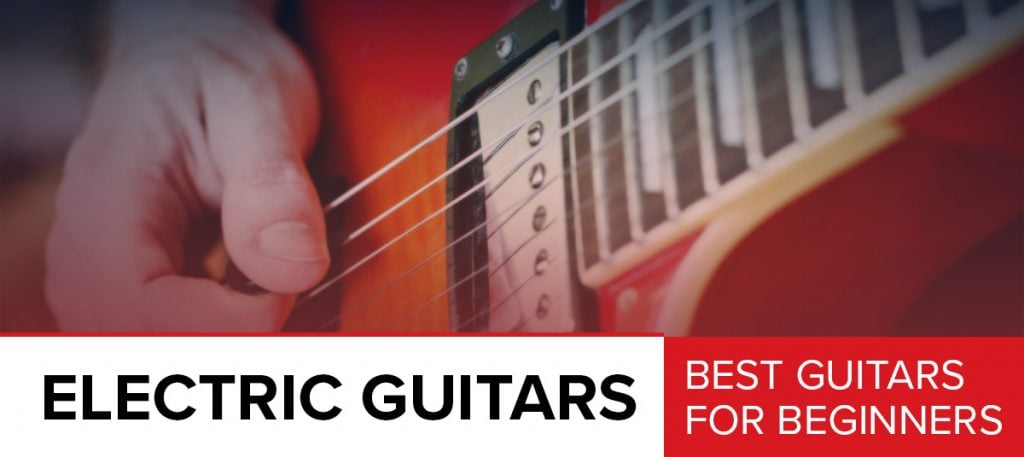
Looking to buy your first guitar? Congratulations – this is a date to remember! Learning the guitar is a life-changing experience, and opens you to a new range of possibilities. But before you can learn, you need a guitar on which to practice and perform.Last Updated: November 18, 2019
For our most recent revisit of this important article, we decided to remove a few older models and instead replace them with some popular guitars that are great for beginners! These additions included the retro-infused Gretsch Electromatic G5425, as well as the Oscar Schmidt OE20, the Dean Custom Zone, and the affordable Epiphone Les Paul Special II.
To help you make an informed decision we have tried, tested and reviewed some of the best beginner’s electric guitars on the market today.
Whether you’re 16 or 60, one of these beautiful guitars will appeal to your taste, style, and budget, and will serve you well for years to come. Stay with us after the chart for a full guide on electric guitars and how to find the best one for you. So here is the list with the best electric guitars for beginners:
Top 10 Best Electric Guitars For Beginners in 2019:
| Image | Electric Guitar / Rating | Summary | Check Price |
|---|---|---|---|
+ - 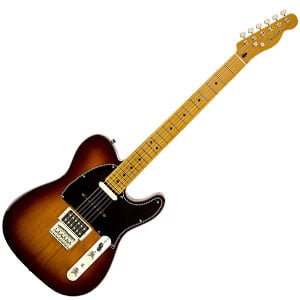 | 1. Fender Modern Player Telecaster Total of 4.76/5 | A real Fender Tele for a killer price. | |
+ -  | 2. Epiphone Les Paul Standard Total of 4.64/5 | A beginners jewel by Epiphone. Superb starting axe. | |
+ - 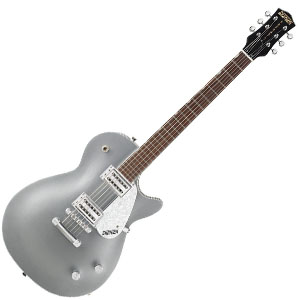 | 3. Gretsch Electromatic G5425 Total of 4.70/5 | A retro Jet with a lot of value for beginners. | |
+ - 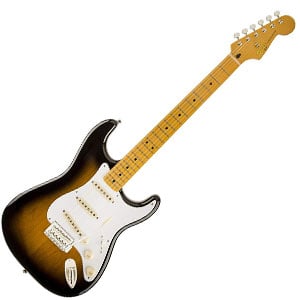 | 4. Squier Classic Vibe Stratocaster 50s Total of 4.74/5 | Old school axe by Fender for the players with extra style. | |
+ -  | 5. Ibanez RG450DX Total of 4.50/5 | After almost 30 years, still a great pick. | |
+ -  | 6. Yamaha Pacifica Series PAC112V Total of 4.58/5 | The classic Yamaha Pacifica with outstanding value. | |
+ - 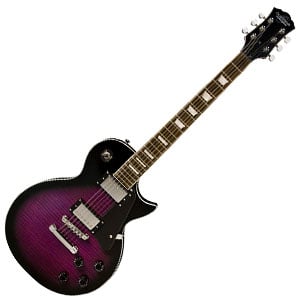 | 7. Oscar Schmidt OE20 Total of 4.62/5 | Plenty for beginners to enjoy on this handsome Les Paul. | |
+ -  | 8. Squier Affinity Jazzmaster HH Total of 4.72/5 | Squier strip away the complication to deliver a fantastic Jazzmaster! | |
+ -  | 9. Epiphone Les Paul Special II Total of 4.60/5 | An authentic Les Paul with a budget price tag. | |
+ - 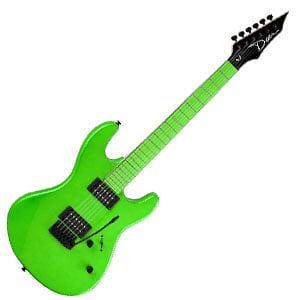 | 10. Dean Custom Zone Total of 4.55/5 | Striking style from an affordable metal machine! |
1. Fender Modern Player Telecaster

| Body And Neck: |  |
| Electronics: |  |
| Hardware: |  |
| Sound: |  |
| Value: |  |
This Modern Player Tele from Fender is an electric guitar that will thoroughly please both beginners and experienced guitarists alike. With the iconic Tele shaped single-cutaway solid pine body, there’s a glossy modern C-shaped maple neck, maple fretboard, and 22 jumbo frets – very comfortable and playable.
The sound is where this guitar shines – it’s just so versatile! This is down to the three pickups, all with very different characteristics. There’s a humbucker at the bridge, a Strat single-coil in the middle, and a Tele single-coil at the neck.
Throw in a five-way pickup selector switch and humbucker coil-tapping, and there’s no end to the sounds you can produce. Check out the full reviewof the Modern Player Telecaster for more on this excellent starter guitar.
2. Epiphone Les Paul Standard
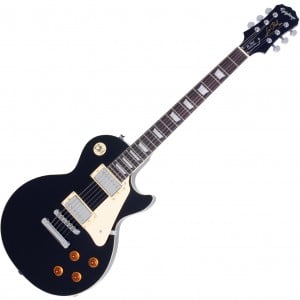
| Body And Neck: |  |
| Electronics: |  |
| Hardware: |  |
| Sound: |  |
| Value: |  |
We start this list with a true classic in the world of electric guitar: the Les Paul Standard. For beginners, this is as close to a Gibson Les Paul as you want to get – and the affordable price really allows you to.
With authentic Les Paul single-cutaway style – in an array of traditional and modern colors – there’s a solid mahogany body with a maple top, a slim D-shaped set mahogany neck, with rosewood fretboard, and 22 medium jumbo frets. Lovely to hold and fun to play.
The sound comes from two Alnico Classic humbuckers at the neck and bridge, which are excellent at handling both clean and overdriven tones, with the warmth and tone you’d expect from Epiphone. In all, an outstanding electric guitar for beginners, as we state in our full review.
3. Gretsch Electromatic G5425

| Body And Neck: |  |
| Hardware: |  |
| Sound: |  |
| Value: |  |
The Gretsch Electromatic G5425 is a new addition to this chart, but scores very highly as it shows off some features that make it an excellent choice for beginners.
In addition to looking awesome, with the cool Jet body, maple neck and retro detailing, the G5425 is made from a chambered basswood, which means its very lightweight and comfortable to hold and practice on for prolonged periods.
The chambering also means it’s a resonant guitar when unplugged, so acoustic practice sessions are more satisfying. However, plugged in with the two humbuckers, this axe really sings – great power for both classic and heavy rock – as we mention in the full Gretsch G5425 review.
4. Squier Classic Vibe Stratocaster 50s

| Body And Neck: |  |
| Electronics: |  |
| Hardware: |  |
| Sound: |  |
| Value: |  |
If you’ve read our full reviewof the 50s Stratocaster, you’ll know that this Classic Vibe Stratocaster is an excellent prospect for any beginner who loves the good old days of rock n’ roll! Made by Squier, this 50s-inspired electric has huge vintage appeal, with a modern feel thanks to a trio of Alnico III single-coil pickups and a smooth, modern C-shaped maple neck (with 21 medium jumbo frets).
The body is made from solid alder with all the classic Strat style you’d expect from a Fender subsidiary, with a real vintage look (especially in the Sherwood Green with matching headstock).
As for the sound, the three single-coils give it authentic Strat tone – well balanced with great clarity and sustain. Affordable, but far from an entry-level model, this is one of the best Squiers around.
5. Ibanez RG450DX
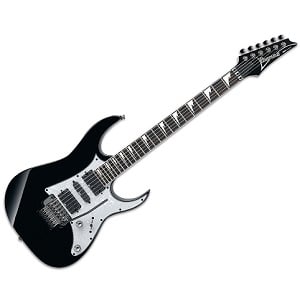
| Body And Neck: |  |
| Electronics: |  |
| Hardware: |  |
| Sound: |  |
| Value: |  |
On a list highlighting affordable, quality, and beginner-friendly guitars it would be a sin to exclude an Ibanez. And the RG450DX more than earns its place – it’s sensational in both sound, style and feel.
With the classic RG double-cutaway body shape, it’s made from solid basswood with a sleek and speedy Wizard III maple neck, with a rosewood fretboard, and a full 24 jumbo frets for excellent soloing capabilities.
The RG450DX – reviewed in full here – has a trio of Quantum pickups, with two humbuckers and a single-coil in the middle, giving this axe mega tone, and plenty of rock aggression. The Edge-Zero II and locking nut finishes it off nicely. A great value classic with a premium feel.
6. Yamaha Pacifica Series PAC112V
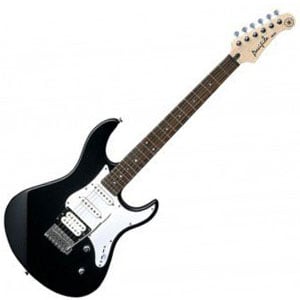
| Body And Neck: |  |
| Electronics: |  |
| Hardware: |  |
| Sound: |  |
| Value: |  |
Yamaha have a reputation for producing affordable, versatile and good-looking electric guitars for beginners, and the Pacifica 112V (as we talk about in detail here) certainly aims to please. The Pacifica series is targeted at beginners, although experienced players would enjoy this just as much.
With a whole rainbow of colors to choose from, an edgy Strat look, and curves in all the right places, the 112V features a solid alder body, bolt-on maple neck, and rosewood fretboard with 22 frets. It’s voiced by three Yamaha-designed Alnico V pickups – a humbucker and two single-coils, for lots of versatility and tone.
The guitar also features a five-way pickup selector switch, coil-tapping on the master tone control, and a vintage-style tremolo with whammy bar. A superb choice for any beginner!
7. Oscar Schmidt OE20

| Body And Neck: |  |
| Electronics: |  |
| Hardware: |  |
| Sound: |  |
| Value: |  |
It’s no secret that we are big admirers of Oscar Schmidt here at Guitar Fella – the Washburn subsidiary always manages to make a quality instrument, whatever category you’re shopping.
The OE20 is a good example of this – an awesome Les Paul-style guitar that comes in a range of unique colors. It’s a handsome guitar that’s built to last and plays very well, making learning a real pleasure. There’s a comfortable mahogany body along with a sleek set neck and rosewood fretboard.
As for sound, this is courtesy of the two humbuckers and a simple range of controls. For the price, it punches well above its weight in terms of sound quality, design and playability. Check out the full review of the OE20 for more!
8. Squier Affinity Jazzmaster HH
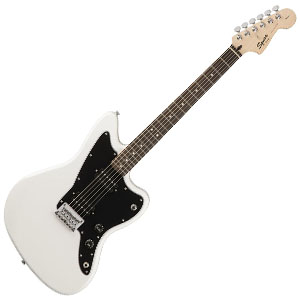
| Body And Neck: |  |
| Hardware: |  |
| Sound: |  |
| Value: |  |
New to this chart is Squier’s affordable Affinity Jazzmaster, which marries the classic Jazzmaster/Jaguar body shape with superb playability and stripped-down electronics to deliver an ideal guitar for beginners.
Sporting the ultra-accessible body shape (made of solid alder), the highlight is the 22-fret C-shaped maple neck which is a real joy to play. It looks great, with that vintage-inspired ’68 headstock, and sounds pretty good too – a little heavier than expected, thanks to the surprisingly hot humbuckers.
The traditional switching system is gone, leaving behind simple beginner-friendly controls – master volume, tone and a three-way switch. It’s a breath of fresh air for beginners wanting something different – as we mention in the complete Squier Affinity Jazzmaster review.
9. Epiphone Les Paul Special II
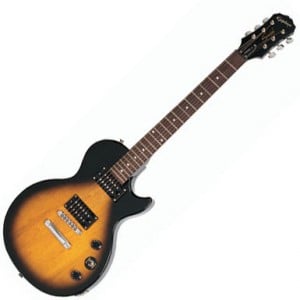
| Body And Neck: |  |
| Electronics: |  |
| Hardware: |  |
| Sound: |  |
| Value: |  |
We couldn’t compile a list of the best beginner electrics without including a ‘real’ Les Paul, from the Gibson subsidiary Epiphone.
The incredibly popular Special II features everything you’d want from both a Les Paul and an affordable beginner’s guitar. This includes the familiar single-cutaway mahogany body, along with a bolt-on okoume neck featuring a comfortable SlimTaper D profile, a rosewood fretboard and 22 frets.
As highlighted in the main review of the Epiphone Les Paul Special II, this guitar comes with two humbuckers (a 650R and a 700T) and simple controls, keeping things easy for beginners, as well as reliable hardware. The highly affordable price is the icing on the cake!
10. Dean Custom Zone

| Body And Neck: |  |
| Hardware: |  |
| Sound: |  |
| Value: |  |
Who says beginners have to learn on something conservative? The Custom Zone is another axe from Dean that offers both style and substance, resulting in an electric guitar that beginners actually want to pick up and play.
With a curvy and comfortable superstrat body made from mahogany, this guitar is finished in either an eye-popping nuclear green or shocking pink, which covers the body and the neck. This bolt-on neck features a hand-friendly C shape, with a sleek satin finish.
As for sound, it’s basic but clear, with two Dean-designed humbuckers offering a punchy tone that’s suitable for everything from your first chords right up to your first metal solos! For more on the Dean Custom Zone, check out our complete review.
In the past, buying an electric guitar wasn’t always as satisfying as it should be. In the days before the internet, you had to rely on the wisdom of your local guitar store, a couple of magazines, and your gut instinct.
You may have ended up with something half decent – if you were lucky – but rarely would you have found your ‘dream guitar’. In fact, without the internet, you probably weren’t aware it even existed!
These days things are different. Thousands of guitars are available to you at the click of a button. You can find everything you need online, from any kind of guitar you could imagine, to amps, strings and even some top-rated guitar lessons for beginners.
As long as you are willing to do some research, you’re likely to walk away with something that really appeals to you and will continue to please you as you grow into a good guitar player.
The Electric Guitar Buying Guide for Beginners
When buying your first guitar, it’s sensible to stop and think about what you are buying it for. Is it just something to learn on? Will you be upgrading in a year or two when you start thinking about forming a band, gigging, and recording?
If so, you may be better off trying one of these affordable electric guitars, which all offer a solid platform on which to learn.
Whatever budget you’re on, you will always be able to find a suitable guitar. Even in the $100 price range you can find some models that play nicely. However, in that super-budget market there is a lot of garbage, so be careful. There’s a difference between ‘affordable’ and ‘cheap’, so do your research before buying something that may offer no value.
Even if you are on a budget, it’s always worth looking in the higher price brackets and considering something a little more expensive, which will offer better sound quality (which is always encouraging), better build quality (usually more comfortable to hold and play), looks cooler (which will keep you motivated), and will last you longer – allowing you to grow with the guitar.
It’s best to buy at the top end of what you can afford. For additional inspiration, make sure to check out this electric guitar list.
Always factor in the size of your instrument. If you are a young player – or are buying a guitar for a child – consider that small hands playing on a full-size guitar may be more difficult than if you had an electric guitar made for kids.
The Anatomy Of An Electric Guitar
If you are serious about buying a guitar and learning how to play on it, you should be familiar with everything one can offer, from woods to pickups. Here’s a brief picture of some of the most important components that make up a guitar, and what you should look out for when browsing:
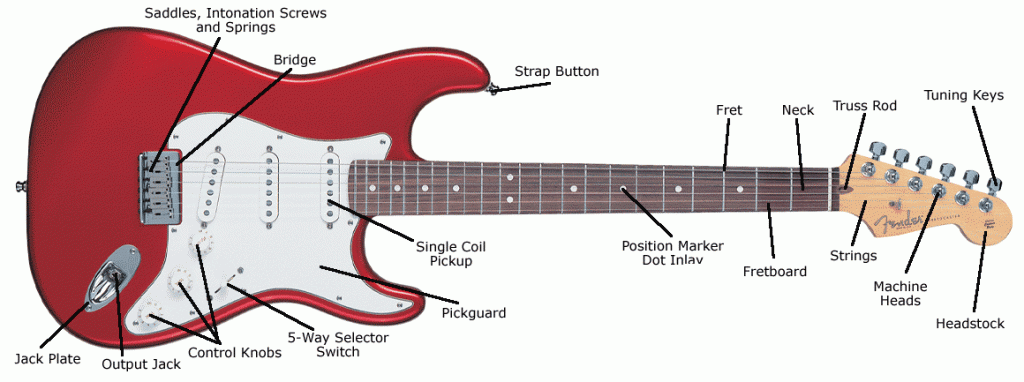
Body Style
Before we go into the parts of an electric guitar, it’s worth noting that there are three different body types: solid body, hollow body, and semi-hollow body. The main difference between them is the way the bodies are constructed, and the amount of resonance they produce.
If you’re into punk, rock, metal, or any style of fast or heavy music, then it should be solid body all the way. It allows for louder sounds and more sustain, while avoiding the feedback issues that affect some hollow bodied instruments at higher volumes.
The hollow and semi-hollow bodied guitars on the market will appeal to players who prefer softer styles, such as jazz, country and blues, as well as soft rock and pop, as they offer a full, rich and more resonant sound with lots of bass.
Beginners will be best off sticking to a solid bodied guitar, as they are easier to handle in most scenarios. For the rest of this anatomical breakdown we’ll focus on solid body guitars.
Body Shape
Solid body guitars offer a fantastic platform for builders, allowing them to craft the wood into literally any shape.
Naturally you’ll probably want to opt for a guitar with a single-cutaway Les Paul or Telecaster style shape, or a double-cutaway shape like a Stratocaster, Yamaha Pacifica, or Ibanez’s RG.
However, the more extroverted beginner can check out some cool styles that always catch the attention, such as V or Z shaped guitars, or anything from Dean Guitars – especially if you want an eye-catching paint job!
Body Wood
Although it’s a minor issue when choosing your first guitar, the tone and sustain that the guitar can produce relies on the quality of the material it’s made from.
The most used tonewoods in the budget range are basswood, poplar, alder, and paulownia, while more expensive guitars can be made from pine, mahogany, and swamp ash. This is just a rough rule though – these days you will find mahogany in budget guitars and basswood in premium models.
They all have different tonal qualities – for example, mahogany typically offers a warmer sound, swamp ash is brighter, while basswood and alder are well-balanced.
Necks
As for necks, the majority of guitars will have either a maple or mahogany neck, with a rosewood, maple or ebony fretboard. Again, there’s no right or wrong, and a neck wood is never going to sway your decision.
But you should choose something that feels smooth and comfortable to play. There are a variety of shapes and profiles, and what you go for will depend on personal preference and playing style.
For example, a modern C-shaped neck is always a safe choice as the majority of guitarists will feel comfortable using it, while a thin U-shape is great for faster players (think punk rock and metal).
Pickups
There are two main types of pickup you’ll find on a guitar suitable for beginners: a single-coil pickup and a humbucker pickup. Without bogging you down in the details of how they work, the single-coil is the classic original pickup, which typically offers a bright and sparkly sound.
As they cut through the mix, single-coils are excellent pickups for lead players. Then comes the faithful humbucker, which – as the name suggests – ‘bucks’ the hum, meaning less background noise.
Humbuckers produce full, meaty sounds found across the world of rock and metal, and are great for lead and rhythm guitar. However you can still play fast punk rock powerchords with a single-coil, just like you can play an upbeat country number with a humbucker!
You’ll usually find two or three pickups on a guitar, although some models will offer just one. Guitars with two or more pickups will come fitted with a pickup selector switch to quickly change between them.
Frets
The frets are those thin metal bars running down the neck, which act as note separators, allowing you to play individual notes and chords. Most guitars will feature 22 frets, although those more rock and metal-inclined will sometimes offer 24, allowing you to reach higher notes.
As a beginner it shouldn’t really bother you whether you have 21, 22, or 24 frets. It’s only as you grow into the instrument you’ll find what works best for you.
Bridge
There are several kinds of bridge (located at the bottom of the guitar, where the strings are attached), but to keep things simple you’ll usually find either a fixed bridge or a tremolo bridge. Both have their pros and cons.
A tremolo bridge will allow you to experiment with everything from vibrato effects right up to full-on divebombs, and can sound amazing when playing high lead solos. However, tremolo bridges can affect tuning, unless the bridge and nut locks.
A fixed bridge is excellent for sustain and tuning stability, although there’s no vibrato. Again, it’s all down to personal preference.
Now you’re a little more informed on the parts that make up a guitar, which may help you when shopping around. For a summary that covers everything we’ve talked about, check out this useful video:
What is The Easiest Type of Electric Guitar to Play?
When buying an electric guitar for the very first time, you may be confused over what is better for you as a beginner – a solid body, a hollow-body or a semi-hollow body.
While you can learn on any of these, we recommend a solid-body guitar, which includes all the models featured on this page. The main advantage of a solid body guitar for beginners is that they are easier to control in front of an amplifier.
By this we mean you are unlikely to experienced squealing feedback from the amp, which can be a big annoyance when it happens all the time. Solid body guitars are often simpler to hold as well, as hollow models tend to be a bit bigger in size.
As we have mentioned above, the more you spend on an electric guitar, the better it should be in terms of playability. If you can aim higher than a super-low budget model, you will be rewarded with upgrades such as a smoother, flatter neck and an easier playing experience all-round.
How Much Should I Pay for a Beginner Electric Guitar?
Technically there is no limit to how much you should pay when buying your first electric guitar. If you have the budget you could learn on something very expensive – similar to learning how to drive in a Ferrari!
However, it isn’t necessary to spend so much on a beginner’s electric guitar. With so many guitar brands and models on the market, manufacturers have had to up their game to ensure their guitars meet a better standard at a lower price.
You can spend under $100 on a beginner’s electric guitar and this would be perfectly acceptable – especially if you are not sure if the instrument is for you. Why waste money if you aren’t sure if you’ll stick to it?
However, if you have aspirations of the stage or recording, you may want to invest a few hundred dollars in something that looks, feels, plays and sounds higher quality. This will save you money in the long run (as you won’t have to upgrade so soon) and will give you a guitar that will be ready for performance when you are.
What’s the Difference Between a Beginner and an Advanced Guitar?
As we have mentioned, it is difficult to categorize a ‘beginner’ or ‘advanced’ electric guitar. Technically, if a newbie wanted to learn on a $2,000 axe, they could. And, if Steve Vai wanted to perform on a $150 starter guitar, then he could!
However, in most cases, there are some differences between what we would class as a beginner electric guitar and an advanced model.
For example, a beginner would benefit from a comfortable and lightweight body, as you wouldn’t really want to wrestle with a heavy, awkward body while trying to simultaneously learn your chords.
However, an advanced player, who is used to playing and holding a guitar, may prefer a heavier body as the heavier the guitar, the better the tone and sustain (in theory at least). It’s therefore wise for beginners to go with a thinner or lighter wood body (such as basswood), as well as an easy-to-hold body shape, such as a Les Paul, Telecaster or Stratocaster (instead of a Flying V, or something similarly awkward).
Looking at hardware and an advanced player may want a range of pickups as well as a lot of controls. For example, they may fancy two humbuckers with coil-splitting capabilities, as well as individual volume and tone controls for each pickup.
Maybe throw in a killswitch too! However, all of this would be excessive for a complete beginner, who would be better off with two humbuckers, one master volume and one master tone control.
Finally, tremolo bridges can be used by both beginners and advanced players, yet a beginner would usually be better off with a fixed bridge. The reason being that adding a variable such as tremolo (aka the whammy bar) isn’t likely to be that useful when you are just learning your first notes and chords.
Tremolos can also negatively affect tuning stability depending on the guitar, which is another reason to avoid them unless you know the guitar is reliable in its tuning (the guitars with tremolo arms that we have highlighted in our chart are reliable enough to justify their inclusion!).
Do You Need an Amplifier for an Electric Guitar?
It may sound like you are asking an obvious question, but it is a very valid question indeed!
First off, no law says you must have an amplifier to play an electric guitar. If you don’t have the budget for one or you just don’t want one for any reason, that’s fine – you can ‘dry practice’. You will still be able to hear yourself playing, although very quietly.
Despite this being acceptable, we do advise buying an amplifier at the same time as your first electric guitar, because dry practicing for too long can encourage some bad habits.
For example, with no amp, you may be playing too aggressively to make yourself heard, which is not a good technique to pick up. Also, by not having an amp, you are also missing the important response and feedback that an amp can offer you on your playing techniques.
Besides – playing with an amp sounds so much cooler!
We suggest factoring the price of a small practice amp into your overall guitar budget. While it may mean you need to settle for a slightly cheaper guitar, the benefits of having an amp from your first day of playing are too good to pass up.
So You Have An Electric Guitar Suitable for Beginners! What Now?
First, let’s hope that with the guitar you also bought some essentials, such as an amplifier and a cable, as well as plectrums, a strap, and a bag.
Wherever you purchase your first guitar from, make sure to take it to a local professional or friend with some experience and ask them to set it up for you. They may charge you a few dollars, but it’ll be worth it to have fresh strings, a good action, and correct tuning. If possible, ask them if you can watch how they set it up, so next time you can try it yourself.
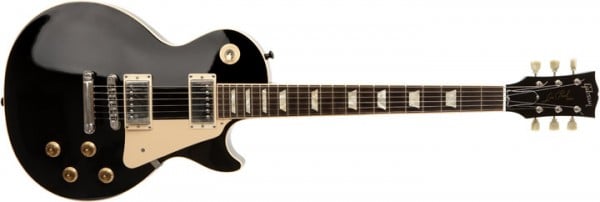
Now, you have your first electric guitar and it’s set up nicely. The next thing you ask is “what is the best way to learn guitar?” And the answer is simple – get some lessons! Whether it’s from your local pro, guitar teacher, or from a range of excellent online courses, lessons will teach you the basics – allowing you to start playing songs within a couple of hours.
Are Online Guitar Lessons Any Good?
Yes, most of them are very useful! These days there are hundreds of online tutors offering great guitar lessons. And there’s no need to throw your money at the first offer you see, as a lot of quality instructional and tutorial videos are completely free on platforms such as YouTube.
Generally, paid courses tend to be better because they are tested and are well-structured, and – in theory – you should be able to progress faster. But it all depends on your budget and on your will to learn on your own.
Finally, have you ever heard a definitive answer to the question “how long does it take to learn guitar?” Us neither!
Learning your first chords can take a few hours, but the instrument can take a lifetime to master. But that’s the joy of playing guitar – you never stop learning. It’s down to you to practise and progress, because practise makes perfect!
The Final Word
As you have seen, there are many great options for electric guitars for beginners, whether you are on a strict budget or things are a little more flexible.
We hope our buyer’s guide has helped answer a few questions and that our chart has been able to offer you some inspiration – although don’t be afraid to shop around and look for something different. However, the ten we have highlighted will at least offer you a solid platform on which to learn.
Good luck with your guitar shopping and first lessons, and keep returning to Guitar Fella for all the latest news, reviews and advice!

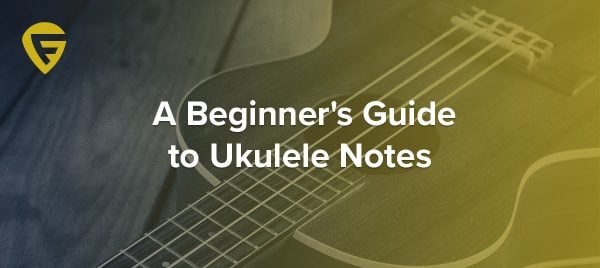
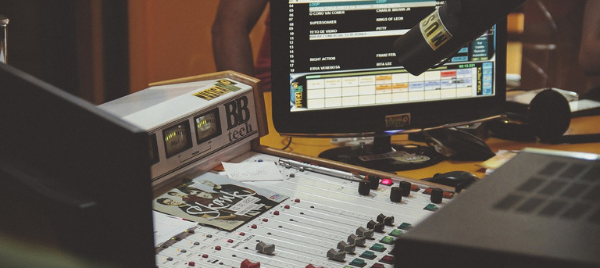
Elizabeth says
Thanks a lot for the great article!!!!! I bought my son an Epiphone Standard and I am the best mom ever since!
ACManiac says
You are welcome Liz, I am glad our article was able to help you out!
Norman says
I was expecting to see at least one Gibson, but I imagine it was hard hard to come with just 10 guitars. Why not expand the list?
ACManiac says
You are welcome Norman! We have a lot of Gibson in the comparison articles. The reason we did not include one in this list is because we do not want to see a newbie focusing more on keeping his guitar safe rather than learning fast 😀
Isaiah says
Also Norman Gibsons tend to be more spendy and I believe since this article is for beginner guitars that they will tend to be cheaper so you can learn without spending much incase you end up loosing interest… however gibbons are quite nice, most of them atlas.
Awkrin says
About the JS32T, does the shape matter? I was hoping to get a dinky or Rhoads? Also possibly Jackson JS32 Dinky DKA-M.
MetzingerDucase says
well.. first.. i’am bassist, and also an audio engineer for my band. and my my guitarist is struggling to find an affordable Electric Guitar, so.. i showed her this web. and she ended up buying the fender modern player tele. and it sounds beautiful!! i was amazed by the tone of this guitar. well.. Many Thanks, mate!!!
Chris says
That’s a good guitar to start with!
InTheHills says
Not a bad article, but I’d go even cheaper. As a long time guitar and bass player (no longer gigging) and father, with guitars high and low cost in the house, I would advise parents to get a new Yamaha, Epi, or Squier (or a good used one of those) for a couple hundred $ or less and a decent Fender or Vox,, Spider, etc modeler amp for the same and see what happens. It has been hard to keep my kids interested, hurts the fingers, and my guitars have low action and play like butter. It isn’t like Rock Star! Reportedly 90% drop out in the first year, and by the time you are my age maybe 99% have quit! Lot of used stuff in the closets out there! So go to a decent store or a friend who plays and seek their help and advice. And get it set up by someone who knows what they are doing. My current favorite setting out and being played a lot is a 1996 Korean Squier Strat Deluxe, used for $99. So if they say spend over $400 total amp and guitar, ask someone else! They lose value real fast!
Gary Gilcrease says
About 30 years ago, a fellow co-worker began teaching me how to play electric guitar. I believe it was an Aria Pro Strat. He had been playing for 20 plus years at this time and was a very good teacher, he owned a 1958 Les Paul. I have not played since he was in a car wreck in 1990 as he could not return to work. He was however able to continue to play, its just our schedules never allowed the time to take lessons. He passed away in 2011, and since I retired last year, I’d like to take up lessons. I found your article very helpful in selecting an electric guitar. It mentions a lot of things most people do not consider when buying.
Thanks!
Gary
Peter says
I played electric guitar in a band from the age of 12 through to the age of 36, then gave it up. Now, at the age of 68 I want to get back into playing. I went into a store and tried playing and found that my fingertips really hurt! Are there any electric guitars where the metal strings don’t hurt or do I just need to “grin and bare it” until my fingertips get calloused again?
Patrick Clark says
Unfortunately there’s not really any good way to get around that issue. You can get strings that ease the pain on your fingers, like Elixirs or D’addarios that are coated but as for the guitar itself you’re going to have to tough it out and build up your callouses and endurance/tolerance. I had the same problem with my fingers, it would happen after playing for longer than an hour usual but over time it went away and now my fingers are rough and hardened. It’s worth the effort and pain, enjoy!
Michael Fitzsimmons says
Want to learn to play, wanted to for years.
Dave says
Great article, thanks!
One question that wasn’t addressed though is even more basic! What’s the difference between a beginner and advanced guitar? What features would a beginner want that an advanced player wouldn’t, and what features would an advanced player like to upgrade that a beginner wouldn’t need yet?
Thanks!
Chris says
Thanks Dave, this is going to be added in an upcoming refresh!